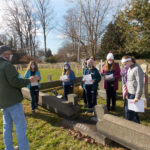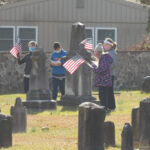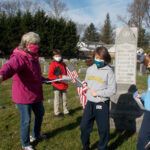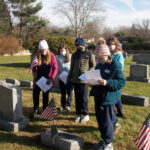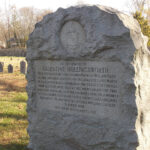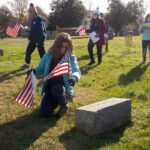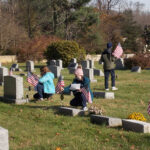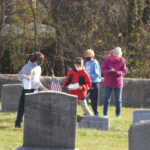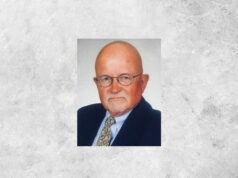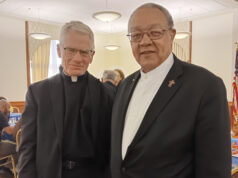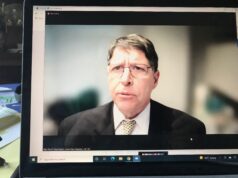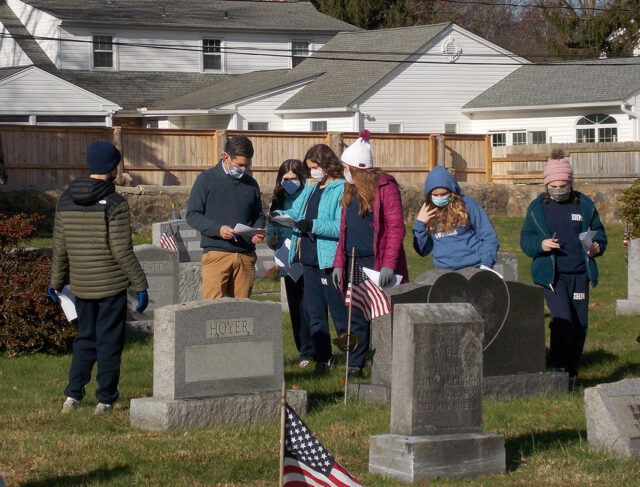
BRANDYWINE HUNDRED — The coronavirus pandemic has taken a bite out of one school fixture, the field trip, for a couple of reasons, not the least of which is that putting large numbers of students on buses just can’t happen right now. But seventh-graders at Immaculate Heart of Mary School in north Wilmington found a way to get some educational time away from the building while observing all of the pandemic’s safety protocols.
The class — in two separate groups — visited the Newark Union Church and Cemetery for Veterans Day. The cemetery is located a few blocks from IHM, so the students and teacher Craig Fischer were able to walk through one of the adjoining neighborhoods and negate the need for vehicular transportation.
Newark Union holds a lot of history, with some tombstones so affected by weather over the past few centuries that they are unreadable. But others are in good condition and show the final resting places of Delaware residents dating back to the 17th century. Many of them are veterans, some from the Revolutionary War.
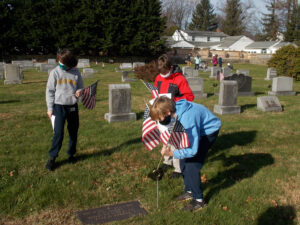
On hand to greet the students were Bob and Anne Daly, who are trustees for the site. Bob Daly, a former Immaculate Heart student, explained the historical significance of the grounds and some of the people buried there, such as Valentine Hollingsworth, who was one of the earliest settlers of Brandywine Hundred. He lived on 1,000 acres of land granted to him by William Penn.
Daly said the church was built in the 1780s and was made a church in 1846. It is currently being renovated and will be available as a museum and meeting space.
He said the cemetery is a treasure trove for history buffs.
“Some of these families (of the people buried there) have really done a lot of research on their families,” he said.
The cemetery provides a jumping-off point for research on the people who are buried there, the periods in which they lived and American life over the centuries, among other topics, Daly said.
“You can really take history any way you want,” he said.
Fischer said the mother of one of his students, Andrew Mahoney, contacted him to suggest a trip to Newark Union. She wrote about “a great piece of Delaware history right up the street, and it’s within walking distance from the school.’ I thought it was a really great opportunity,” Fischer said.
Andrew said he didn’t know his class was visiting the cemetery. “I used to come up here a lot when I was little.”
His classmate, Jimmy Weir, recognized several of the names. “My art teacher, (Bobbi) Forwood, we’ve seen her relatives’ tombstones. Weldins, the Sharpleys.
“I think it’s really cool. They used to walk around near this place, and most of us have set foot where they have.”
Gretchen Tonn, another student, was surprised at how old some of the markers were. Hollingsworth, who donated the land that the cemetery is on, died in 1710. She and her friends liked the bronze dog marking the grave of a family pet, and she was struck by the familiarity of the names on the graves.
“It’s basically like a piece of Delaware,” she said.
Normally, the seventh grade would visit the Kalmar Nyckel in Wilmington, the replica of the Swedish ship that brought settlers to America. But with that off the table, Fischer was thrilled to have a place so significant that close to the school.
“To be able to get the kids out, walk around and make it a productive one where we learn about our local history and actually do some community work as well. We’re hoping if the weather stays OK to maybe bring the eighth grade later on,” he said.
Bob Daly described some of the families with members interred at the cemetery. They were names familiar to residents of northern New Castle County: Weldin, Sharpley, Grubb and Talley, among others. The military veterans among them have medallions at their headstones indicating the war they fought in, and the students were able to place flags on each one.
“We get a chance to honor veterans that served in those wars and other wars, too. I think that’s really cool,” Fischer said.
All photos by Mike Lang.



